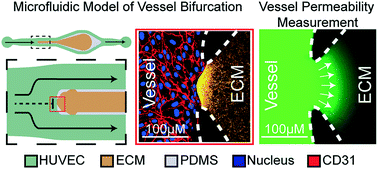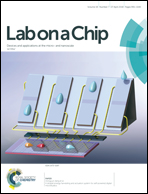Flow dynamics control endothelial permeability in a microfluidic vessel bifurcation model†
Abstract
Endothelial barrier function is known to be regulated by a number of molecular mechanisms; however, the role of biomechanical signals associated with blood flow is comparatively less explored. Biomimetic microfluidic models comprised of vessel analogues that are lined with endothelial cells (ECs) have been developed to help answer several fundamental questions in endothelial mechanobiology. However, previously described microfluidic models have been primarily restricted to single straight or two parallel vessel analogues, which do not model the bifurcating vessel networks typically present in physiology. Therefore, the effects of hemodynamic stresses that arise due to bifurcating vessel geometries on ECs are not well understood. Here, we introduce and characterize a microfluidic model that mimics both the flow conditions and the endothelial/extracellular matrix (ECM) architecture of bifurcating blood vessels to systematically monitor changes in endothelial permeability mediated by the local flow dynamics at specific locations along the bifurcating vessel structure. We show that bifurcated fluid flow (BFF) that arises only at the base of a vessel bifurcation and is characterized by stagnation pressure of ∼38 dyn cm−2 and approximately zero shear stress induces significant decrease in EC permeability compared to the static control condition in a nitric oxide (NO)-dependent manner. Similarly, intravascular laminar shear stress (LSS) (3 dyn cm−2) oriented tangential to ECs located downstream of the vessel bifurcation also causes a significant decrease in permeability compared to the static control condition via the NO pathway. In contrast, co-application of transvascular flow (TVF) (∼1 μm s−1) with BFF and LSS rescues vessel permeability to the level of the static control condition, which suggests that TVF has a competing role against the stabilization effects of BFF and LSS. These findings introduce BFF at the base of vessel bifurcations as an important regulator of vessel permeability and suggest a mechanism by which local flow dynamics control vascular function in vivo.

- This article is part of the themed collection: Lab on a Chip Emerging Investigators


 Please wait while we load your content...
Please wait while we load your content...